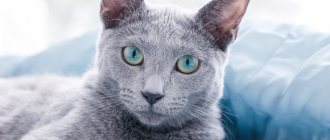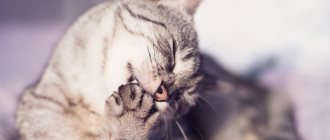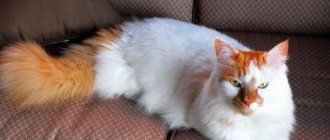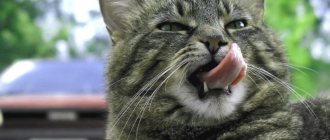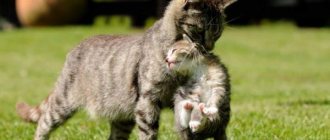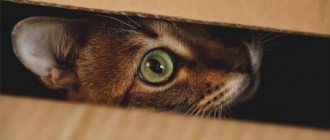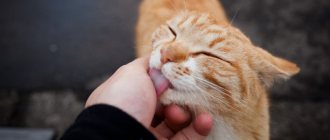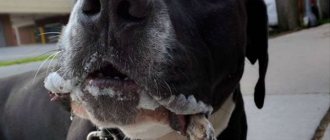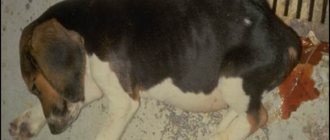There are a number of reasons why a cat shakes its tail, the most mobile part of its body. As an extension of the spine, the tail is equipped with a dense network of nerve fibers. Thanks to this, various movements are considered by a person as a kind of “language” of the pet and allow the owner to understand his cat. Unlike dogs, cats convey many emotions with their tail.
Why does a cat twitch its tail?
To understand what this pet behavior expresses, you need to pay attention to the direction in which the tail moves. The environment in which the cat is located is also important. With the help of his tail, he tries to express his emotions, which are both negative and positive:
- Anxiety. The tail moves sharply in the horizontal plane. The flattened ears confirm the uncomfortable state of the animal, experiencing dissatisfaction and fear. In a panic, a cat is unpredictable, so you should eliminate the cause - take the animal away from the irritating object. A tail swaying to the sides is a sign that the pet is busy hunting and preparing to attack. In nature, this can often be observed when large wild cats are about to attack prey. Pets behave in the same way when playing with an inanimate object.
- Doubt. The need to make one choice or another is often another reason why a cat shakes its tail. The behavior of these animals has a lot in common with humans. Living nearby for thousands of years has brought certain results. While thinking about something, a person may involuntarily shake his leg or tap his fingers on the table. The cat, faced with a choice, rhythmically twitches its tail. At the same time, there are no other signals indicating his concern or anxiety. It is enough to help the animal make a decision, and the process will stop.
- Satisfaction. A cat can also express positive feelings using its tail. The animal conveys a feeling of calm and happiness by twitching the tip of its tail. When showing tender feelings towards a pet, stroking and scratching, this can be observed constantly. The cat expresses reciprocal feelings by purring and lightly twitching its tail. This means that everything that happens gives him satisfaction.
- Interest. This is also a common reason why a cat's tail twitches. At the same time, their movements are performed rhythmically and slowly. The pet's state is relaxed, all attention is focused on any one object. The cat can walk around it, peering with caution, sniffing and examining it. A cat's curiosity manifests itself in a similar way when the owner brings home a bag of groceries.
When trying to understand the state of a pet by twitching its tail, it is necessary to take into account the environment and other signals given by the animal.
Causes of tail shaking
Not only cats, but also cats can mark territory by shaking their tail.
Tails are considered an ornament for pets, especially long-haired ones. This is an important part of the body, thanks to which animals are able to land on their paws when jumping from a height. Tails help to maintain balance and walk on thin bars. At the same time, it is an indicator of the emotional and physical state of kittens and adults. The strange behavior of a pet can be easily understood by observing the movements of its tail. If he twitches and shakes sharply, it means that the pet is dissatisfied with something. There are several reasons why an animal nervously shakes its tail or finely shakes its tip.
Interest
Often such movements of this part of the body are characteristic of animals engaged in observation.
A curious kitten or adult pet shows interest by staring or continuously observing a place or living thing. At this time, the cat twitches its tail, but does it constantly, slowly, calmly. In general, this position indicates concentration or relaxation with a degree of interest. A striking example is the owner returning home in the evening with a bag of groceries when the cat is waiting for him at the door.
Satisfaction
If a kitten or an adult cat's tail twitches frequently, this can be perceived as irritation, although this sign indicates satisfaction. This is how cats behave when they are happy with what is happening around them, with food, and with attention from their owner. The movement of the tail is complemented by purring. If a pet behaves this way, then its owner also has nothing to worry about.
Marks territory
By performing such an action, the fluffy wants to show that he is the owner of this territory.
Marking an area or a specific object is important in the life of every pet. This is how in the animal world there is an appropriation of territory, a declaration of one’s rights, a division of possessions between cats, and an exchange of information. The cat shakes its tail very finely when it marks the selected object, while pointing its tail upward. There are cats that do the same procedure. It looks the same as cats do, with the only exception that the marks are made with urine. If for the former this is typical behavior of a male, then in the second case it is the animal’s way of relieving stress. To get rid of the troubles associated with the private behavior of a pet, it is castrated. It is recommended to carry out the procedure while the animal is young.
Expressing doubt
Just like a person, a cat can be faced with a choice. At the same time, the pet’s tail shakes and spins in different directions chaotically. The animal does not show any emotions either with its body or sounds. This behavior means that the pet does not know what to do. Perhaps he does not understand what is happening and he needs the owner’s help in explaining the current situation.
Anxiety
This movement of the bone process can be observed in a pet that has gone hunting.
During times of tension, fear, or extreme alertness, the cat jerks its tail from side to side horizontally. This suggests that the animal accepts the challenge and will not only defend itself, but is also ready to attack. The pet may have an arched back, as if from fear, but more often it presses slightly to the ground. An example of this behavior is hunting or playing, when the cat presses its ears and constantly twirls its tail.
Why does a domestic cat shake as if it were cold?
To prevent this from happening, you need to treat your pet only positively and affectionately.
If your cat is trembling, and you don’t care about it, then don’t talk about it, the pet has changed in behavior and has begun to irritate you. There is no need to leave the cat in this situation. It needs to be solved!
Joy and positive emotions
Joy is the opposite of fear and stress. A cat may tremble because it is happy and joyful. For example, when you were away from home for a long time, and then you came, your pet was very happy to see you and this made him start shaking. The cat is also trembling because he has eaten delicious food. This is because his muscles are contracting.
Sexual arousal
A cat may begin to tremble when she becomes sexually aroused, that is, in heat. At this moment her senses are very heightened. Therefore, if you do not want to breed kittens, you need to have your pet spayed or neutered (if desired).
When to contact a veterinarian
After you have examined all the causes of trembling in a cat, and none of them suits you, you need to urgently contact a veterinarian. It is he who will be able to make an accurate diagnosis and prescribe treatment.
Why does the animal run and nervously lick itself?
Licking is normal for cats. These clean animals are so sensitive to the cleanliness of their fur that they lick themselves at every opportunity: after eating, going to the toilet, or being touched by their owners. Moreover, by licking their fur coat, they calm down. Licking can be talked about as a normal phenomenon only when it is not fanatical in nature. Why does a kitten or adult cat run around the house and lick nervously?
The cat is stressed
These animals have a very vulnerable psyche. It doesn’t take much for a pet to lose its peace of mind. This can happen due to a trip in a car, a visit to the veterinarian, quarrels in the family, the appearance of a new four-legged inhabitant in the house, moving to another room, changing place of residence, etc. All cats experience stress differently. Some begin to run aimlessly around the apartment and fanatically lick the fur. Sometimes they do this so violently that in some areas of their bodies they become completely bald.
As soon as the factor that provoked the cat’s emotional shock disappears or he gets used to new circumstances, the pet will stop being nervous. However, cats are not always able to overcome stress on their own. Sometimes they need sedatives.
Hyperesthesia syndrome
This rather rare disorder, affecting the skin, neuromuscular and nervous systems, is most often detected in kittens. The reasons for its appearance are unknown, but it is believed to be due to disruption of neurotransmitters in the brain during anxiety.
Animals with this syndrome feel tense all the time and experience increased sensitivity to touch. Their spine and tail are the most vulnerable. They lick the fur too diligently, paying special attention to the most vulnerable areas of the body, sometimes leading to the appearance of bloody wounds. Hyperesthesia syndrome can also be recognized by other symptoms:
- nervous tail beating;
- twitching of parts of the body in the back;
- sudden bursts of activity, sometimes developing into aggression;
- dilated pupils;
- tail biting;
- loud meow.
The cat has fleas, worms or other parasites
The reason for this behavior may be ecto- and endoparasites. They cause the pet a lot of suffering. Especially unbearable for them is the endless itching in places affected by external parasites, such as fleas. It prevents the tailed poor fellows from sleeping peacefully, eating, and spending time carefree. In order to somehow drown it out, they begin to rush around the house and actively lick the irritated skin, often only aggravating the situation.
Having noticed symptoms of a helminthic infestation in a cat, it is necessary to take measures to destroy the pests as quickly as possible. Antiparasitic drugs, especially if they are planned to be used to treat a kitten, should be discussed with your veterinarian.
How does a tail reveal your mood?
The sign language of animals is unusually developed. And if it’s not always possible to determine a pet’s mood by its face, then its tail gives it away. He will convey everything that the cat likes or dislikes with his condition.
- You can tell if a cat is in a playful mood if the tail twitches when held upright. When he begins to make sharp blows to the floor, this is a signal that it is time to stop the game.
- The irritated state of a pet can be determined by its tail jerking sharply from side to side. In some cases, a raised tail with a curved tip indicates that the cat is nervous.
- Feelings of pain and stress also often cause a cat to twitch its tail. She makes smaller movements with it, sometimes knocking on the floor.
- If the fur on the back rises along with the twitching of the tail, this means that the animal is in an extreme state of excitement and is capable of attacking.
Knowing the possible reasons why a cat may twitch its tail, it is easy to determine its mood and needs. This behavior is not necessarily a signal of negative feelings. The ability to read the sign language that animals speak helps establish mutual understanding between the owner and the pet.
You can also contact our site's staff veterinarian, who will respond to them as soon as possible in the comment box below.
Communication by posture.
The head is raised, the back is straight - the cat is all attention, although relaxed.
The head is lowered, the ears and whiskers are pressed down, the fur is not bristled, the tail is pressed to the body and, perhaps, wags, touching the ground - fear and a desire to sneak away.
Fullface is an angry but very brave cat. If he turns to face the enemy, baring his teeth and arching his back - beware, the cat may attack.
The cat gloomily crouches to the ground, emits a long low growl, the tail is pressed to the body or wags from side to side - readiness for a fight - this means that he has abandoned his intentions.
The cat lies on its back (showing its belly) - evidence of friendship and trust, asking to scratch its belly.
His back is arched, the back of his body slightly sank to the ground, his fur bristled - intimidation, the cat is deciding whether to defend itself or attack, very strong irritation and readiness to defend.
Stroking a person with a paw is a sign of close affection and tenderness.
Massage of the owner's body parts (trampling) is the highest bliss.
Dancing is a sincere love for the one to whom these dances are dedicated. Cats lift their two front paws off the ground and quickly put them back, with their paws completely straight and tense. After this, the cat very often rubs against the legs of the person whom she greeted in this way.
What other reasons for movement are there?
Tail movements indicate not only the mood of the pet, but also the state of its health. If the cat's behavior is unusual, you need to examine the animal and observe it.
If a cat shakes its tail, it means it is “speaking” and wants to be understood. There are a number of common “phrases” that are expressed by moving the tail:
Regularly repeated movements of this part of the body must be understood and carried out by the owner of what the furry is asking him to do.
Communication using paws.
Rubs and massages with a paw - this is the cat’s complete satisfaction.
The cat gives you a paw on the crack or pulls at your clothes - it means it’s asking for something (food, a toy, affection, etc.).
A hug with your paws is an instillation of your love.
Relaxed paw raise - The cat suddenly stops and lifts one front paw while relaxing the lower part of the paw so that it hangs slightly. After this, the entire appearance of the animal indicates that it has completely concentrated its attention on something, for example, on a smell. The signal indicates that something unexpected or puzzling has caught the cat's attention and she is trying to determine what it is, while trying not to betray her interest with some awkward movement.
Paw strikes are a cat's means of defense.
Types and signs of seizures
There are several signs by which seizures are usually classified:
- non-epileptic and epileptic seizures can be based on the mechanism of development;
- according to prevalence, they distinguish between limited or local/focal, generalized and unilateral;
- Based on the time during which a group of muscle fibers contracts, they are divided into: myoclonic, tonic and clonic convulsions.
Epileptic convulsions occur under the influence of hypersynchronous discharge. As is known, the brain, or more precisely, neurons communicate through weak electrical discharges; the simultaneous discharge of a large group of neurons leads to characteristic attacks of uncontrolled muscle contractions.
Non-epileptic seizures can have a wide variety of causes, from vitamin B6 deficiency, toxin poisoning, convulsive form of fainting to endocrine disorders or organic damage to brain structures.
Myolonic seizures are short-term seizures.
Clonic - represent a frequent change in the tone of muscle fibers or their groups, in other words, twitching.
Tonic is a fairly prolonged muscle spasm.
The animal, neither during the attack nor after it, can in any way describe its condition, so the owner needs to be very attentive to his pet, and if he notices the following signs, be sure to take the cat for a consultation to the clinic, even if after the attack the animal looks healthy:
- convulsions of the whole body or convulsive twitching of the paws;
- tense, crooked legs tucked under the stomach;
- loud painful cry of an animal with cramped limbs;
- the animal falls to the floor in convulsions or moves its paws back, as if trying to stretch;
- the animal's pupils are dilated, its whiskers are pressed down;
- if the convulsions are focal, the animal is conscious, it is not given to the owner;
- involuntary urination (in severe cases);
- foaming from the mouth (also in severe cases).
With mild cramps of the limbs, sometimes the animal tries to rise, but to no avail. But more often, until the end of the attack, the cat is afraid to move, because movements can cause pain. But pain is not necessary. Sometimes convulsive attacks are not accompanied by severe discomfort, so the animal can behave calmly, despite the twitching limbs.
After the seizure ends, the animal can behave as usual, as if nothing had happened. Or he may lose orientation for a while and not find his favorite place or bowl.
Causes of nighttime paw twitching
Scientists have long established that cats dream. It also turned out that they, like people, have two phases of sleep: superficial and deep. During light sleep, the animal's brain is in a semi-active state, as some parts of it continue to function.
This can lead to nightmares, involuntary movements, sounds, and even teeth grinding. If a cat's paws move in its sleep, then most likely the animal is in the stage of shallow sleep and there is no need to worry. But if, in addition to twitching, other symptoms are detected:
- foam from the mouth;
- twistedness of one or more limbs;
- involuntary urination;
- pressed mustache;
- dilated pupils.
In such cases, the problem cannot be ignored; the animal must be shown to a veterinarian. This condition may indicate an attack of epilepsy or seizures.
There are also other possible reasons, including tumors in the brain, pathologies of the heart, respiratory system, excess or deficiency of certain vitamins and minerals, intoxication and others.
So why do cats need tails?
1. Tails help us cats maintain balance when, for example, we walk along some thin perch or sneak along a fence. You've probably already noticed that when cats find themselves in a similar situation, they begin to wag their tail to gain balance.
2. With the help of our tails, we show our other relatives and you people what mood we are in.
Mood #1 “Peace, I love you!” - the tail is a pipe, and there is calmness on the face;
Attitude #2: “You’re finished! War is inevitable! - the tail sticks out like a “pipe”, and the fur all over the tail stands on end;
Mood No. 3 “Hide, everyone!” This mindset is essentially similar to mindset #2. Only in this case, we swing our tail from side to side, with increasing speed, and even hit ourselves with our tail on our own sides.
Caution - rabies
If the cat is free-range, its behavior must be observed especially carefully. On the street there is a high risk of contracting various infectious diseases, many of which are fatal.
Having noticed a twitching of the tail and back of a freedom-loving cat, the owner needs to sound the alarm and find out why this is happening. These symptoms are often used to identify rabies. This disease is dangerous for both the pet and its owner. It threatens irreversible damage to the spinal cord and brain. In addition to the fact that the animal begins to twitch its tail and back, there are other signs of rabies :
- the cat eats food but refuses to drink water;
- the animal becomes aggressive or, conversely, tries to hide from people;
- have difficulty swallowing food;
- saliva is produced profusely;
- the pet begins to constantly bite itself at the place through which the infection entered the cat’s body.
But whatever the symptoms, only a veterinarian can accurately answer the question of why the cat is twitching its tail. However, if rabies is confirmed, the animal will have to be euthanized.
What else will the tail tell you?
When an animal is in a state of tranquility, the fifth section of the spine is always relaxed, hanging in a natural position. If the cat is lying down, then this part of the body is wrapped around the body.
When he meets his owner after a long day of work, he runs out to the front door with his tail held high. And this pose means that the pet is very happy to meet you, he was bored and waiting. A proudly raised ponytail is a sign of friendliness. The animal communicates that it is waiting for a return greeting and stroking.
Sometimes you can observe that the animal holds this part of the body strictly vertically and gently shakes and twitches it. This form of behavior is an expression of playfulness. It borders on sexual arousal. Males in this position can mark territory.
But even an inexperienced owner can notice the irritation of a cat. At such moments, pets move their tail left and right with sharp movements. Some may hit the floor with it like a whip: it is better not to tease the animal at this time.
How to treat tremors and seizures in cats
When trying to figure out how to cure tremors in a cat, the animal owner often acts by analogy with human diseases. This is the wrong way, because... The organisms of cats and humans are structured differently. Sometimes the owner, without realizing this, begins self-treatment. At the same time, he wastes time: the effect of therapy is not achieved, the signs of the disease are sometimes erased, but the disease itself progresses.
You need to understand that tremor in a cat can be treated only after the cause is determined. Without examination, laboratory and instrumental studies, an accurate diagnosis cannot be made.
Further prognosis depends on the type of pathology. Sometimes a course of vitamins is enough to completely restore the conduction of nerve impulses. However, the disease often cannot be treated. Each specific case requires separate consideration.
The author of the publication is veterinarian Irina Barabash. She began her career as the chief veterinarian of a collective farm, and since 1998 she has been working as a veterinarian and toxicologist chemist at the regional laboratory of veterinary medicine. He combines his main work with writing publications on specialized topics.
Treatment methods
Head tremors of a physiological nature, for example, before preparing to jump or during sexual activity of an animal, do not require treatment. In case of pathological processes, a mandatory examination in the clinic, examination, and hardware diagnostics are required. Antiparasitic drops in the ears are prescribed as a treatment for otodectosis. In the case of otitis media, it is necessary to include a group of antibiotics. Diseases of a neurological nature or failure of internal organs require specific treatment. In this case, only an experienced veterinarian can prescribe a complex of drugs.
Lovers of fluffy kittens need to constantly monitor the health of their pet, promptly bring it to the clinic for diagnostics, and undergo preventive examinations and vaccinations. A responsible attitude will help prevent illness and make your four-legged friend happy and active.
The cat is shaking
It is absolutely impossible to notice the appearance of tremors in a pet. Sometimes you can’t see it (small tremors), but if you just touch the cat’s body with your hand, it will be felt.
Trembling can also be severe, with it the limbs usually begin to twitch intensely , this is very noticeable in hairless breeds of cats, as well as smooth-haired ones.
It is impossible to confuse such a symptom with others (for example, with a cramp). Many owners, seeing that their beloved cat is trembling like a leaf, immediately, without finding out all the reasons, fall into a state of panic.
Communication with the eyes.
The eyes are wide open and looking straight at you - the cat is all attention, interested in what you say or do.
Pupil dilation is an important signal in both cats and humans, but it is not necessarily associated with attack or defense.
Half-closed eyes indicate drowsiness, calmness or caution; they indicate a friendly disposition - this is a signal of trust and affection.
Pupils like slits - aggressiveness, which means the cat is on guard and confident.
Round pupils, crazy look - fear, the cat is scared, be careful.
The eyes twinkle and blink - the cat expresses his gratitude.
The vision is clouded, the third eyelid - the cat may be sick or relaxed, or offended.
The cat stares at you - this is a challenge, keep your distance.
If the cat crouches to the ground and does not look at you, this is submission.
